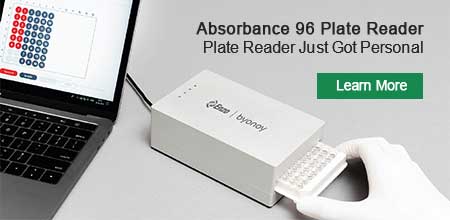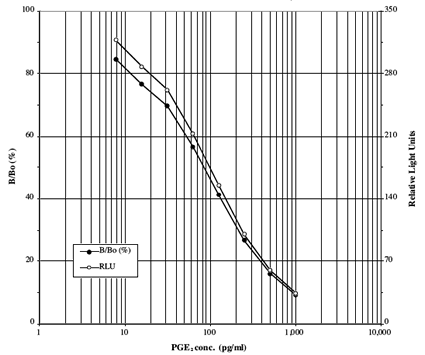- Validated in numerous sample matrices
- Results in just 3 hours
- Sensitive to 6.03 pg/ml
- Results from up to 36 samples in duplicate per plate
The PGE2 CLIA kit is a sensitive chemiluminescent competitive enzyme immunoassay kit for the quantitative determination of PGE2 in biological fluids from any species.
Please mouse over
Product Details
| Alternative Name: | Prostaglandin E2 |
| |
| Sensitivity: | 6.03 pg/ml (range 7.81 - 1,000 pg/ml) |
| |
| Assay Time: | 3 hours |
| |
| Applications: | Chemiluminescence
|
| |
| Application Notes: | For the quantitative determination of PGE2 in culture supernatants, serum, saliva, urine, and whole blood from any species. |
| |
| Species reactivity: | Species independent
|
| |
| Use/Stability: | Store all components at 4°C, except standard and conjugate at -20°C. |
| |
| Shipping: | Blue Ice |
| |
| Contents: | White GxM IgG Microtiter plate, Conjugate, Antibody, Assay buffer, Wash buffer concentrate, Standard, CLIA Substrate |
| |
| Scientific Background: | Prostaglandin E2 (PGE2) is an extensively studied prostaglandin owing to its predominance in inflammation, cancer, atherosclerosis, autoimmune disease, and sepsis. Oxidation of arachidonic acid by prostaglandin synthases (COX-1 and COX-2) produces prostaglandin H2 (PGH2), which is further metabolized by PGE synthases into its major product, PGE2. PGE2 mediates autocrine and paracrine signaling by binding to G-protein coupled receptors (EP1, EP2, EP3, EP4) on the cell surface, functioning to modulate phospholipase C and adenylate cyclase activity. PGE2 has been of great interest as a therapeutic target, either by modulation of its synthesis by COX inhibitors (NSAIDS) or by modulation of its receptors by downregulation or binding antagonists. PGE2 production in a variety of tissues has been shown to modulate numerous physiological processes including natriuresis in the kidney, smooth muscle elasticity in the vasculature, and the inflammatory response to damaged tissues by monocytes and macrophages. |
| |
| Regulatory Status: | RUO - Research Use Only |
| |
| Compatibility: | This product is compatible with the Absorbance 96 Plate Reader.
 |
| |
Product Literature References
Spinal inflammatory hyperalgesia is mediated by prostaglandin E receptors of the EP2 subtype: H. Reinold, et al.; J. Clin. Invest.
115, 673 (2005),
Application(s): PGE2 from the thoracolumbar segment of the spinal cord was measured, mice,
Abstract;
Full Text
Effect of a Selective Cyclooxygenase-2 Inhibitor, Nimesulide, on the Growth of Lung Tumors and Their Expression of Cyclooxygenase-2 and Peroxisome Proliferator- Activated Receptor-{gamma}: M.S. Shaik, et al. ; Clin. Cancer Res.
10, 1521 (2004),
Application(s): EIA using mouse tissue,
Abstract;
Differential Expression of Platelet-Activating Factor Acetylhydrolase in Macrophages and Monocyte-Derived Dendritic Cells: S. Al-Darmaki, et al. ; J. Immunol.
170, 167 (2003),
Application(s): EIA using human culture supernatants,
Abstract;
Inhibition of Cyclooxygenase-2 by Rofecoxib Attenuates the Growth and Metastatic Potential of Colorectal Carcinoma in Mice: M. Yao, et al.; Cancer Res.
63, 586 (2003),
Application(s): Concentration of PGE2 in splenic tumor cystosolic fractions were determined using mouse tissue,
Abstract;
Microsomal Prostaglandin E Synthase-1 Is a Major Terminal Synthase That Is Selectively Up-Regulated During Cyclooxygenase-2-Dependent Prostaglandin E2 Production in the Rat Adjuvant-Induced Arthritis Model: D. Claveau, et al.; J. Immunol.
170, 4738 (2003),
Application(s): PGE2 production was determined by enzyme immunoassay analysis using rat tissue,
Abstract;
Iloprost suppresses connective tissue growth factor production in fibroblasts and in the skin of scleroderma patients: R. Stratton, et al. ; J. Clin. Invest.
108, 241 (2001),
Application(s): EIA using human culture supernatants,
Abstract;
Promoter Methylation Regulates Helicobacter pylori-stimulated Cyclooxygenase-2 Expression in Gastric Epithelial Cells: M. Akhtar, et al.; Cancer Res.
61, 2399 (2001),
Application(s): EIA using cell culture supernatant,
Abstract;
Full Text
Inflammatory Agonists Induce Cyclooxygenase Type 2 Expression by Human Neutrophils: C.G. Maloney, et al.; J. Immunol.
160, 1402 (1998),
Application(s): EIA using human cell culture supernatant,
Abstract;
Related Products













